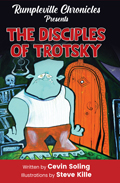
 |
Sniffles is an ogre with poor personal hygiene and a bad disposition, partly due to the pickaxe stuck in the back of his head. Rumors suggest that his mother placed a curse on the pickaxe so that anyone who removed the pickaxe would immediately perish. Sniffles meets another ogre even meaner than himself, likely because the new ogre, Lucky, has a pickaxe embedded in the front of his head. The two ogres commiserate about their misfortunes and the fate of the proletariat. They decide to embrace a bit of Marxism and overthrow the monarchy of the kingdom. The two quickly find other disgruntled workers, including six of the seven dwarfs, Rumpelstiltskin, the three bears, and the Big Good Wolf. The group trains hard to get into fighting shape, learn military logistics, and understand the philosophy of their movement. However, things soon begin to fall apart. Red Riding Hood’s grandmother disagrees on philosophical issues. Dopey, Tom Thumb, and Mama Bear are kicked out for not restricting all actions to the destruction of bourgeois culture. Wolf, leading the military, is in crisis as he sees the group becoming just like those he despised. Eventually, only Sniffles and Lucky are left. They are overwhelmed by a group of children who want to play ring toss.
There are many influences on this graphic novel from Soling as well as allusions to historical people and events. One thing that comes to mind is the rise in popularity of fractured fairy tales. From beloved picture books like Jon Scieszka’s The Stinky Cheese Man and Other Fairly Stupid Tales to the excellent children’s series The Sisters Grimm by Michael Buckley, through the teen series The Lunar Chronicles by Marissa Meyers, and concluding with Erin Morgenstern’s wonderfully vivid novel, The Night Circus, fractured or twisted fairy tales have been riding a prolonged high in popularity. All operate with a similar structure of using fairy tales but breaking them in a significant way. Then there is the direct parallel to George Orwell’s classic novel about the Russian Revolution and the rise of Stalinism, Animal Farm. Trotsky, a force during the revolution who is eventually exiled and then assassinated by Stalin, is represented by Orwell as one of the animals, much as the ogres represent either Trotsky or one of Trotsky’s followers. Additionally, their failed attempt parallels Trotsky’s own failure to defeat Stalin.
Soling combines a practiced writing style with a few sections of lengthier exposition within the context of a graphic novel. There is one instance of a repeated phrase, but there are no real grammatical issues to hamper the reading experience. In this work, the narrative combines serious, world-shaping occurrences and ideas with intended sophomoric sarcasm and humor. However, there isn’t enough development of the larger, impactful issues to hold up under the weight of the latter. Readers familiar with the ideas, or those who have recently read Animal Farm, could find this an entertaining and palate-cleansing tale. Meanwhile, fans of the satirical wit found in back issues of Mad magazine and Cracked will likely find Soling’s work vastly appealing.